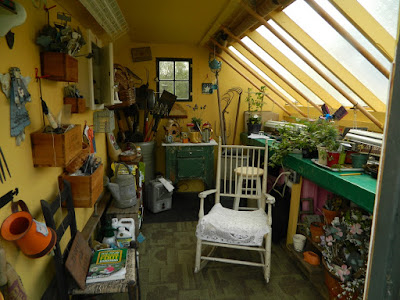cold frame /kōl(d) frām/
noun
A four-sided frame of boards with a removable glass or plastic top. The frame is placed on the ground and is used to house, protect, and harden off seedlings and small plants, without artificial heat.
-- New Oxford American DictionaryI've wanted a cold frame for a long time but never imagined I would own such a grand one. Years ago, I coveted a potting shed/greenhouse combination I spotted at one of the big box stores. We purchased it and placed it as the focal point of my yet-to-be-planned-and-planted kitchen garden. We built raised beds around the shed (we couldn't plant directly into the ground with the proximity of a walnut tree and its toxic roots) and eventually added fences. My kitchen garden took shape.
 |
| The construction of the potting shed completed 2006 |
 |
| Raised beds for square-foot gardening |
 |
| We added a picket fence on two sides and a pasture fence on the other sides. |
Over the years we made important changes to the inside of the potting shed. H.H. hung shop lights with grow lamps over the potting bench for my trays of seedlings on sunless days. We added a framework to support roller shades of bamboo for too-sunny days.
 |
| Potting bench with seedlings. |
Always wishing to extend the growing season, we added insulation to the potting shed so that I could put seedlings (that I start in the house) out in the shed a little earlier. I painted the inside a sunny yellow and added treasured items from the attic of our 1850's farmhouse.
 |
| We added insulation in 2013 |
 |
| Purdy's rocking chair is a family piece probably more than a century old. |
I painted the shed a barn-red color, added some chickens (H.H. wont let me keep real ones because of the foxes and coyotes that inhabit our fields and woods) and I was content ... for a time.
 |
| My collection of chickens |
I love my potting shed and have written extensively about it over the years. You'd think I would be satisfied, wouldn't you? But I saw a cold frame at the Bloomsburg Fair last year and started reading about winter gardening with cold frames.
 |
| Bloomsburg Cold Frame |
I pictured my seeds sprouting in a warm protected enclosure; my tender seedlings kept safe from wind and frost. I visualized a simple box structure, maybe topped with old windows, like the one at Bloomsburg. Then I talked with Victor.
The son-in-law of a dear friend, Victor is a musician, photographer, graphic designer, owner of a small construction/renovation company, and (cold frame) visionary. I told him I would like my cold frame attached to the south side of the potting shed. We discussed materials (non toxic, of course), size, and pitch of the roof. The latter proved to be the critical factor in making the add-on look part of the original building and, incidentally, very attractive. Victor felt the pitch of the cold frame's roof should match that of the shed/greenhouse structure. He was right!
 |
| Victor used cedar wood that he insulated and lined with a composite material. |
 |
| He put wire mesh in the bottom to keep out critters. |
Victor made four separate 'lids' covered with the same plastic material as the roof panels -- called Lexan®. The lids are very light and attached with lift-off hinges so I can remove them easily.
 |
| Victor put a new coat of barn-red paint on shed and on cold frame to complete the 'look.' |
You may notice in the picture above that Victor also replaced the rotting logs that bordered the long lasagna-garden on the extreme right. He used the same composite that lines the cold frame. Now my kitchen garden, with all it's new construction, is very snazzy!
We shoveled endless loads of my special compost mix into the new planting area. I couldn't wait to add plants although it was a record 90°F day in May. I sowed a row of Swiss chard at the back where the design allows for taller plants. I sowed carrots and, of course, you have to have lettuce in a cold frame, don't you? I can prop the lids open or take them off, but I soon found it is easier to heat the soil up in a cold frame than it is to cool it down ...
 |
| Fried lettuce |
Obviously, the cold frame will come into its own at each end of the gardening season. I plan to get a jump start on my spring garden by planting cabbage, chard, kale, radish, spinach and, of course, lettuce, in late winter next year. This should add more than a month to my spring garden season. I dread the coming of the first fall frost and look forward to planning how I will extend this year's growing period.
Thank you, Victor. I love it! Now I trust I've made some of my dear gardening friends green (appropriate color) with envy. Please check out Victor's website by clicking here. He enjoyed the challenge and would love to make more.
Love,
Pamela x
I love reading your comments. I hope you leave one so I’ll know you visited!
I look forward to visiting your blog in return.
































